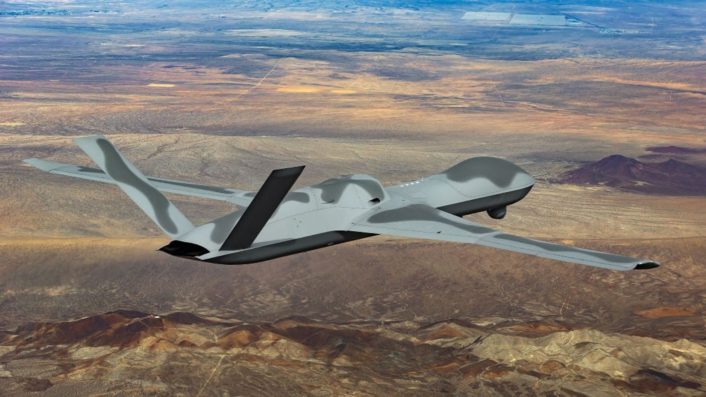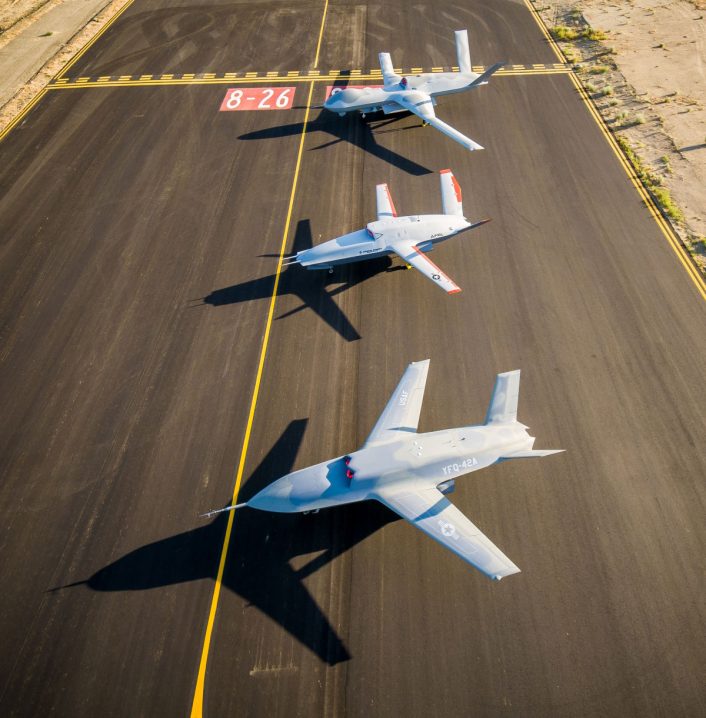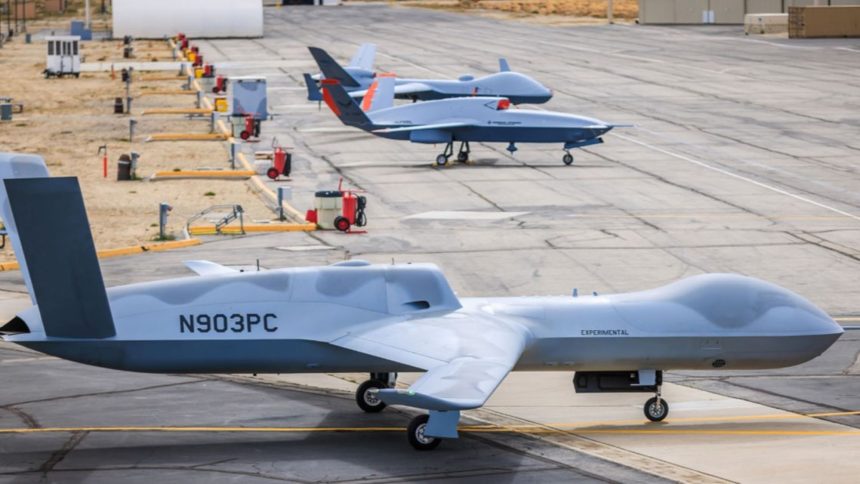The test demonstrated long-range kill chain effects, including an autonomous air-to-air engagement, by using beyond-line-of-sight (BLOS) Command and Control (C2).
The MQ-20 Avenger Unmanned Combat Aerial Vehicle (UCAV) conducted another simulated air-to-air engagement on Jul. 8, 2025, announced General Atomics-Aeronautical Systems (GA-ASI) on Jul. 17, 2025. The test, which involved both live and simulated aircraft, was far more expansive in its scope, leveraging near and far-away sensors to achieve long-range kill-chain effects.
The new test comes a little over a month after the Avenger, using ShieldAI’s Hivemind autonomy software, conducted on Jun. 11 a simulated autonomous shootdown as part of an exercise involving multiple live and virtual aircraft. Shield AI further mentioned that the UCAV’s digital twin was also involved.
These activities followed the testing, during the Orange Flag 25-1 test exercise in February 2025, of a reference autonomy stack on the MQ-20. The UCAV switched controls between Shield AI’s Hivemind autonomy software and the government-provided autonomy software to validate both programs’ maturity.
GA-ASI showcases maturity and operational #readiness in a groundbreaking demonstration of autonomous tasking with TacACE and Optix.C2 in its latest #MQ20 Avenger® autonomous jet demo featuring live air-to-air engagement capability.
Read the news: https://t.co/Ua93NBrQLd… pic.twitter.com/EbPFoVCIN7
— General Atomics Aeronautical Systems, Inc (GA-ASI) (@GenAtomics_ASI) July 17, 2025
The new test
The test event featured the integration of a Collaborative Combat Aircraft (CCA), a fully compliant government owned autonomy implementation, and beyond-line-of-sight (BLOS) Command and Control (C2), explained GA-ASI. The company-owned MQ-20 Avenger acted as a CCA surrogate, with the press release noting it was in a sensor Emission Control (EMCON) environment.
A total of four CCA surrogates was employed, of which one live (the MQ-20) and three virtual. The drone operated autonomously, receiving real-time situational awareness and autonomous tasking through the Tactical Autonomy Core Ecosystem (TacACE) to close the kill chain.
The operations were controlled using distributed-edge C2 nodes powered by Optix.C2 and Omniview software, which allowed Beyond Line-of-Sight (BLOS) Command and Control (C2). Optix.C2, a product from General Atomics-Intelligence, provided low-latency, localized C2 functionality while remaining networked to the broader operational picture, enabling real-time coordination across multiple domains.
Dr. Brian Ralston, President of GA-Intelligence said in the release: “The Optix data platform and C2 capability enable rapid integration and experimentation to address critical DoD and IC [Intelligence Community] needs.”
The flight also saw General Atomics successfully fusing space-based sensing and tactical sensing with the C2 node, giving the aircraft access to a complete real-time threat picture for enhanced onboard autonomous decision-making. “The demonstration also included live coordination of Intelligence, Surveillance, and Reconnaissance (ISR) and kinetic tasking through a unified operator interface capable of deployment in virtually any cloud environment,” the release said.

Leveraging off-board sensors for passive collection of aerial target movement, observing the EMCON constraint to avoid emissions by onboard sensors, the MQ-20 autonomously patrolled a designated Combat Air Patrol (CAP) zone. The four CCA surrogates were then directed by an operator to investigate multiple targets of interest. Upon identifying them as threats, the operator issued a command to initiate BLOS engagement.
“The autonomous systems maneuvered into position, simulated missile launches, assessed battle damage, and returned to CAP without additional operator input,” GA-ASI described in the release. GA-ASI’s Vice President of Advanced Programs Michael Atwood called the demonstration “a substantial leap in autonomy and human-machine interfaces critical in the near-peer fight.”
Mission autonomy. Live-virtual-constructive. Powered by Hivemind.
In our latest #MQ20 Avenger flight with @GenAtomics_ASI, Hivemind flew both the live #aircraft and its digital twin—executing real combat maneuvers in a live-virtual op.
“Readiness means flying today, not… pic.twitter.com/TcPIJZS54C
— Shield AI (@shieldaitech) June 17, 2025
“By integrating Optix.C2 with TacACE, we’re delivering a system that not only operates at the tactical edge but also enables rapid decision-making and execution across the battlespace,” Atwood added. “This is the future of warfare – scalable, autonomous systems that empower the warfighter to dominate at range.”
Previous tests
The MQ-20 Avenger’s Jun. 11 test with Shield AI’s Hivemind autonomy software, which saw the UCAV conducting complex missions with both live and virtual aircraft in its first simulated air-to-air kill, was primarily meant to validate the Hivemind and Autonomy-Government Reference Architecture (A-GRA) interfaces.
For the best domain awareness deep within the battlespace, look to our jet-powered Gambit Series of autonomous collaborative platforms. #GambitUAS are modular and tailorable uncrewed systems that can be finely tuned for the most particular and demanding missions.
Our next-gen… pic.twitter.com/kENH5K3pVJ
— General Atomics Aeronautical Systems, Inc (GA-ASI) (@GenAtomics_ASI) July 20, 2025
That test also saw the live and virtual MQ-20 Avengers communicating with each other and conducting CAP maneuvers and formation flying, demonstrating advanced tactical behaviour in a two-ship team, ShieldAI engineers and team members said in a short feature released by the company. The complex air-to-air maneuvers and coordination between different assets are important parts of the validation of autonomy software, as the unmanned aircraft are expected to reliably cooperate with manned assets.
Once that was achieved, GA-ASI moved to demonstrate an actual real world representative scenario using space assets and C2 setups for BLOS air-to-air engagements. The goal is to have the drones operating safely and reliably with minimal operator input.
Relevance
While reporting about the first simulated test air-to-air engagement of the MQ-20 Avenger and Turkey’s sophisticated drone and UCAV programs, we explained how it is very much possible for tier one air forces, with supporting assets like 4th, 4.5, 5th generation fighters, AEW&C (Airborne Early Warning and Control) and satellites, to engage hostile aerial targets at long-ranges with AAMs.
Autonomous flight – delivered at record speed. Through rapid development and integration, GA-ASI continues to prove speed to flight during a recent demonstration of @ShieldAItech AI-powered autonomy software aboard our MQ-20 Avenger®.
Learn more: https://t.co/d4F20WVnE8 pic.twitter.com/AALMWFqitJ
— General Atomics Aeronautical Systems, Inc (GA-ASI) (@GenAtomics_ASI) March 4, 2025
The low-cost and safe unmanned option offers reasonably effective air denial options over relatively low-risk sectors, unburdening manned fighters, thereby saving both critical airframe life and freeing up resources.
Here is what we wrote at the time:
“Scenarios like enforcing air denial that need merely firing an AAM onto a hostile target, differentiated by an unfamiliar radar signature and possibly negative indications on an Identification Friend or Foe (IFF) interrogations, can easily be undertaken by UAVs. This becomes even more viable if the air force has other supporting assets like Generation 4, 4.5 and 5 aircraft, Airborne Early Warning and Control (AEW&C) and satellites.”
The description of the parameters of the latest test broadly validates that analysis. Additionally, GA-ASI has also partnered with Sweden’s Saab to have a podded AEW capability for its RPAs (Remotely Piloted Aircraft) in the MQ-9 series.
It is unclear if the C2 software mentioned earlier might have some application in the MQ-9B Reapers or the RG1 Protectors that would receive Saab’s podded systems. The aircraft might also be used as nodes to relay data to other nearby unmanned assets.
GA-ASI is at the forefront of advancing autonomy. The #GambitUAS series of uncrewed collaborative aircraft are modular, tailorable and affordable. Enabled by our expertise in software, control systems and human-machine interfaces, there’s a variant for every mission.… pic.twitter.com/4IfO9GA3li
— General Atomics Aeronautical Systems, Inc (GA-ASI) (@GenAtomics_ASI) June 17, 2025
MQ-20, XQ-67A and YFQ-42A
The image released by GA-ASI accompanying the press release also showed an MQ-20 Avenger beside an XQ-67A OBSS (Off-Board Sensing Station). While the MQ-20 was the only live asset confirmed to be involved, the XQ-67 might be involved in future because of its ability to act as an off-board sensor platform.
The XQ-67A itself conducted an autonomy integration demonstration with a government-owned software, GA-ASI announced on Jul. 16, 2025. The goal was to enable dynamic mission execution and real-time coordination with both crewed and uncrewed systems.

The jet-powered Avenger, that GA-ASI uses as a test-bed for future Autonomous Collaborative Platforms (ACP), is being trialled concurrently with the XQ-67A. Both are being used to validate different yet complementary technological aspects of the CCA program, such as off-board sensing, off-board weapons engagement, AI-enabled autonomous flight technology and mandatory government-reference interfaces and software architectures.
The testing is not casual as GA-ASI produces the YFQ-42A which, together with Anduril’s YFQ-44A, will be among the first CCAs that are soon expected to fly alongside manned fighters.









